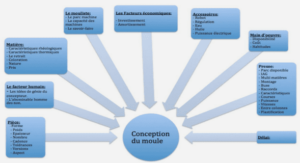In general, the purpose of this thesis is to identify a framework for optimization of supply chain management. It is based on the identified characteristics of supply chain management optimization and processes of SCM optimization. All supply chain functions including supplier, manufacturing, warehousing, and transportation have to align their strategies to minimize total functional cost. Simply put, optimization approaches are used to improve the relationships within firm and stages across the SC.
In particular, the three main objectives of this thesis are as follows:
1. Model a supply chain management problem.
2. Propose an approach for solution using the meta-heuristics.
3. Validate the proposed approach by a case study: automobile industry supply chain.
The literature review has focused on identifying essential definitions required for the reader to understand the research studied. In recent years, extensive research has been conducted in areas such as supply chain management, optimization and meta-heuristics by presenting various studies. In this section of the thesis, we describe supply chain management, optimization models, driver models and the solution methods.
The evolution of the concept of SCM can be dated back to 1950s, a period commonly referred to as the logistics era. At that time, the SCM concept was not valued as a strategic function (Ballou, 1978). However, in the early 1960s, the importance of logistics was established due to the recognition of physical distribution management as a separate function unto itself (Heskett et al., 1964). The period was known as the first transformational era. Most importantly, the concept of SCM was first presented by logistics consultants in the 1980s (Oliver et al., 1992). This meant that the SC could be viewed as a single entity and that the top-level management was entitled to make decisions. The concept was universally accepted by logistics experts and marketing theorists who focused on managing all the processes that are required to provide the customer with value and to expand the understanding of logistics (Gripsrud et al., 2006). Today, SCM has evolved to become an important management function that affects the ability of organizations to run profitable enterprises. According to Christopher (1992), “leading-edge companies have realized the real competition is not company against company, but rather supply chain against supply chain”.
A lot of definitions have been proposed regarding the concept of supply chain management but most of them agree that it is goal is to coordinate activities within the firm to create value for the customers. It also integrates, manages and is responsible for the flow of materials by coordinating the whole materials process. In addition, it requires joint relationships with several organizational functions and several types of partners. According to Monczka et al (1998) SCM’s “primary objective is to integrate and manage the sourcing, flow, and control of materials using a total systems perspective across multiple functions and multiple tiers of suppliers.” Nevertheless, there is no generally accepted definition for the term “supply chain management”. Therefore, Christopher (1992) defined the supply chain as a network of organizations involved in different processes that create value for the customer through upstream and downstream linkages. His definition touched on manufacturers, suppliers, vendors, wholesalers, retailers and the customer. In a general outlook, the supply chain is the network of entities through which materials flow. Those entities may include manufacturing sites, suppliers, distribution centers, carriers, retailers, and customers (Lummus et al., 1997). In addition, “the supply chain considers all of the following activities: sourcing, procurement, production scheduling, transportation, warehousing, inventory management, order processing, and customer service. Basically, everything associated with moving materials / products from the raw materials stage through to the customers” (Quinn, 1997).
In recent years, modeling and optimizing complex SCM systems have gained increasing popularity among researchers due to expanding competition, changing customer demands, shorter product lifecycles, rising product and market complexity. Thus, optimizing SCM frameworks can provide some critical support for decision making in a competitive market.
The fundamental approaches to modelling and optimizing supply chain management can be divided into five distinct classes according to Dong (2001) as following:
1- Fundamental formulation of supply chains.
2- Stochastic programming.
3- Integer-mixed programming.
4- Heuristic techniques.
5- Simulation-based methods.
These approaches are very valuable alternatives for solving large-scale problems efficiently because traditional simulation techniques for modeling and optimizing complex SCM require huge amounts of computing resources (Sanchez et al., 2007). Thus, meta-heuristics approaches and related methods are widely used for an optimization SCM. As firms have become conscious of the significance of supply chain performance and operational performance progress as well as integration and coordination of the distribution and production operations have been acknowledged as the competitive advantage source. The objective of an optimization SCM is to determine the best combination of parameters for the job, optimize activities in a SC and provide the best solutions to the problems at hand. However, this task can be very complex (Ateme-Nguema et al., 2007).
What is a Supply Chain?
Modern firms are increasingly being compelled to increase their market share in order to meet the growth objectives and survive in the competitive environment. At the same time, the firms must protect their domestic market share from global competitors. Managers are thus confronted with a challenge of how to develop their firms’ global logistics and distribution with the intention to fulfill the customer demands in the rapidly changing global supply chain (Handfield, 2002). Handfield states that the strategic positioning of inventories is an important tool towards promoting the prompt availability of products to the customer. Also, Domenica (2003) states that the supply chain ought to be effective and efficient. While its efficiency is measured via the ability to minimize the use of resources to achieve specific outcomes and effectiveness results from the proper design of distribution channels. The specific measures of efficiency in the supply chain are delivery performance, quality of products, the prevalence of backorders and inventory.
Moreover, managers can measure effectiveness using the quality of service and with reference to service needs. Domenica’s (2003) parameters suggest that the firm’s long-term effectiveness is dependent upon the satisfaction of customer preferences regarding cost, service delivery, quality expectations and flexibility. Thus, all these activities of the SC network are considered a constant challenge for the companies (Ernst, 2002) . This translates to the design of a more efficient and more effective SC relative to the supply chain adopted by competitors.
INTRODUCTION |





